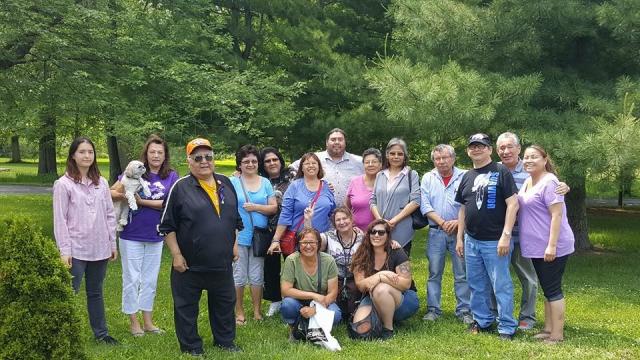Residential school survivors and University of Toronto students gather to build relationships and find pathways to reconciliation.

The Healing Fund has the privilege of supporting many worthwhile projects focusing on language revitalization, cultural restoration, and healing initiatives in Indigenous communities across Canada. I was excited to visit a project in Toronto by the Toronto Council Fire Native Cultural Centre. Council Fire’s project is called “Naandwidizwin Wechihitita” Healing Ourselves – Helping Each Other and it focuses on the immediate and long-term healing needs of Residential School Survivors and their families through blending contemporary and traditional Indigenous approaches to mental health and well-being. One focus of the project is to educate the community about the Indian Residential School experience.
This year, Council Fire’s Naandwidizwin Wechihitita project partnered with the University of Toronto in Scarborough to help its sociology students learn about the Indian Residential School System based on the understanding and perspectives of the residential school survivors group from Council Fire. This 12-week course also focused on the Truth and Reconciliation Commission of Canada (TRC), allyship, reconciliation, and restorative justice through relationship building with the residential school survivors group.
The day I visited, the classroom chairs were set up in a circle and Elder Andrew Wesley opened the circle by burning some sage. Sage is a traditional medicine that many Indigenous peoples use to clear our minds and hearts and promote balance. The aroma of burning sage was pleasant but I was surprised to see medicine burning because the university does not usually allow it. It felt nice to see Indigenous practices included in the classroom.
The University of Toronto principal was there to share news about upcoming Indigenous Education Initiatives program and to get feedback from the students. I heard the students and the residential school survivors group mainly ask to give hiring preference to Indigenous professors, provide more course content with an Indigenous worldview, advertise Indigenous courses to all students, create land-based and experiential courses, and grow traditional medicines (i.e. sage, tobacco, sweet grass, and cedar) in and around the campus.
Students expressed that learning from the residential school survivors group really opened their eyes about what is happening in the country. They said they learned that now is the time to create the space to discuss reconciliation among students, to understand how we are all connected, and to work to improve relationships with each other. I sat there thinking how amazing this all was, but I was saddened to hear that some students experience negative feedback from others when they raise Indigenous issues at home or community. However, I also felt hope because perhaps this is the generation (Indigenous and non-Indigenous) that will help bring greater change towards an equal and just society.
The last time I visited this project was at their final class held at the Toronto Council Fire Native Cultural Centre. This time the chairs were set up facing forward, which I thought was strange because the chairs are usually in a circle. One of the students walked in and expressed a similar sentiment by stating incredulously, “Where is our circle? What happened to our paradigm?” I could not help but giggle quietly to myself. I love it when Indigenous culture is appreciated and normalized.
This last class focused on the student’s final projects on promoting reconciliation in the community, while the residential school survivors group watched from the audience. Some examples include starting a water campaign to raise awareness about contaminated water in Indigenous communities—especially since society takes clean water for granted because it is so accessible. Another student created a PowerPoint presentation of different Indigenous artwork. The student shared that Indigenous art is unique and wanted to recognize this and promote its preservation. Another student decided to volunteer at the breakfast program with one of the Indigenous agencies in the city.
The motivation I witnessed among the students to contribute to the movement of reconciliation was amazing. The students shared that if it were not for the course content that focused on Indigenous worldviews and teachings and building relationships with the residential school survivors group, it would have just been another class. I left feeling appreciative and filled with hope in witnessing the positive impacts of this partnership. I hope these spaces continue to emerge in settings across the country.
—Honarine Scott is Cree from Fort Albany First Nation and is the Healing Programs Coordinator in the Aboriginal Ministries Circle in The United Church of Canada.